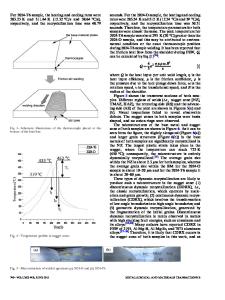Mechanical Tensioning of High-Strength Aluminum Alloy Friction Stir Welds
- PDF / 1,387,078 Bytes
- 14 Pages / 593.972 x 792 pts Page_size
- 52 Downloads / 360 Views
INTRODUCTION
THE presence of residual stresses in welded components is known to have a significant influence on the fatigue behavior and, therefore, on the lifetime of the welded component.[1,2] As a result, much of the prior research on the residual stress distribution resulting from friction stir welding (FSW)[3–8] has been performed with a view to determining the welding parameters that minimize the residual stresses and, therefore, extend the lifetime performance of the component. The characteristic features of the residual stress distribution in FSW tend[3] to be similar to those for fusion welding.[9,10] This is largely because the mechanical effects of the FSW tool on the residual stress level appear to be slight, compared to the thermal effects of the tool.[11] In common with most welding methods, the region around the FS weld is associated with tensile residual stresses that are largest in the welding direction and that are balanced by compressive stresses further away from the weld line. The magnitude of residual stresses in FS welds varies from J. ALTENKIRCH is with the School of Materials, University of Manchester, and the Institute Laue-Langevin. P.J. WITHERS is with the School of Materials, University of Manchester, Manchester M1 7HS, United Kingdom. Contact e-mail: philip.withers@manchester. ac.uk A. STEUWER is with ESS Scandinavia, 22350 Lund, Sweden, and the Institute Laue-Langevin, 38042 Grenoble, France. M.J. PEEL is with the European Synchrotron Radiation Facility, 38042 Grenoble, France. S.W. WILLIAMS is with the Welding Engineering Research Centre, Cranfield University, Bedfordshire MK43 0AL, United Kingdom. M. POAD is with Airbus UK, New Filton House, Filton, Bristol BS99 7AR, United Kingdom. Manuscript submitted May 16, 2008. Article published online October 21, 2008 3246—VOLUME 39A, DECEMBER 2008
alloy to alloy and also depends on the welding parameters applied, but it is common for the peak residual stresses to approach the local room-temperature yield point of the alloy.[8,12] Depending on the thickness geometry of the welded component, the welding residual stresses may be partially accommodated by distortion both longitudinal (L) (bending or buckling distortion) and transverse (T) (angular or butterfly distortion) to the weld (Figure 1), as well as by rotational distortion and shrinkage.[10] Bhide et al.[13] encountered buckling distortion for HSLA-65 steel FS welds in 6.25-mm plates, compared to angular and bending distortions for submerged arc and gas metal arc welding, due to a broader, lower-level tensile residual stress weld zone and significant compressive stresses in the parent plate lateral to the weld. Welding distortion can be a significant problem and may require expensive postweld correction procedures. In practice, there is a limit to the extent that residual stresses can be reduced simply by optimizing the welding conditions.[8] Furthermore, other requirements, such as the avoidance of the introduction of flaws and the drive to maintain economic production rates, may constrain the w
Data Loading...











